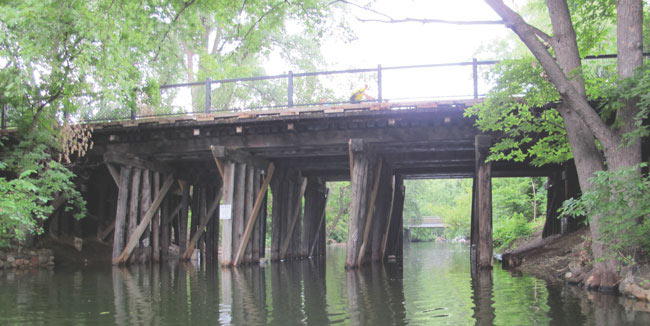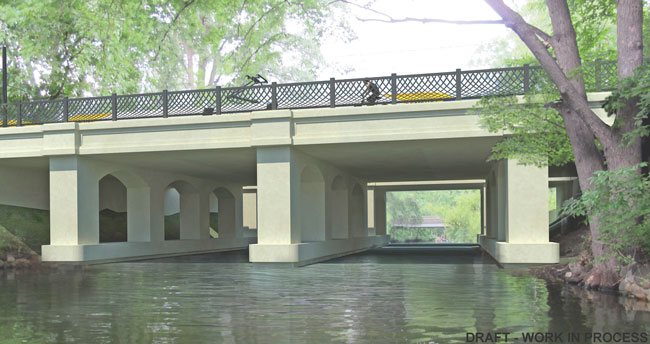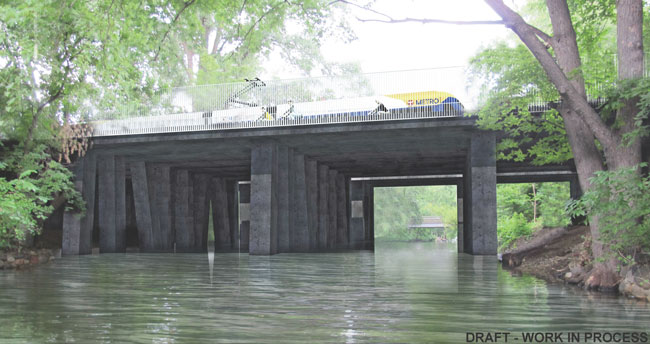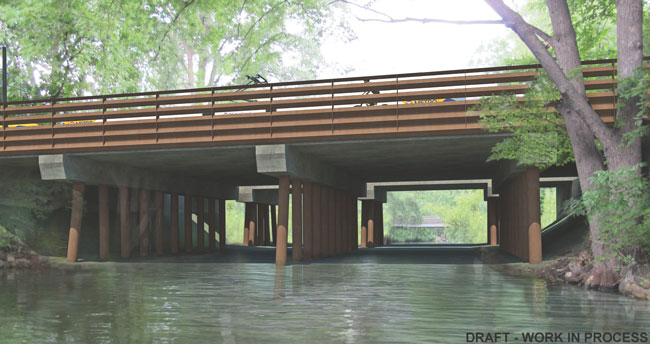Three bridge concepts presented today for the Kenilworth channel crossing on Southwest LRT (METRO Green Line Extension) would reinterpret the existing wooden railroad bridge with new low-profile structures.
The project designers’ concepts feature arches, angled piers and a thin deck reminiscent of the existing railroad bridge and are fashioned to fit in with the natural surroundings, as initially recommended by several parties. These parties include the Minnesota Department of Transportation, the State Historic Preservation Office, the Minneapolis Park and Recreation Board, the city of Minneapolis and Kenwood Isles Area Association. Structural engineers tested the concepts, and designers presented them today to these parties and staff of the five corridor cities and Hennepin County.
“These are not full-blown designs. They are just in the idea stage for discussion as part of our consultation process for historic properties,” said Jim Alexander, director of design and engineering for the Southwest LRT Project.
The consultation, a federal requirement, will continue throughout the design process in 2015 for the freight railroad bridge and the combined LRT/trail bridge over the channel between Cedar Lake and Lake of the Isles.
About the three concepts
The three bridge concepts are called arched pier, thin deck and steel pier.
To minimize the visual impact and hazards for channel users, all three bridge concepts would be supported from below only with just three rows of piers, down from the six on the existing wooden railroad bridge.
Poles holding the overhead wires that carry electricity to power the trains would not be located on the bridge. In the current concepts, they would be set substantially back from the banks of the channel.
Input that led to the three concepts
The concepts are based on initial input from the consulting parties. Their initial recommendations were:
- Maximize light between new freight railroad bridge and the LRT/trail bridge, which would be 9 feet apart
- Recognize relationship between bridges and embankment
- Restore vegetation and consider treatment of partially eroded embankments
- Consider relationship between abutments and embankments
- Create more space for skiers, canoeists and kayakers by reducing the number of piers from six rows on the existing wooden railroad bridge. (All three concepts show only three rows of piers on each bridge.)
- Use natural materials
- Employ a utilitarian design
- Reinterpret existing wooden railroad trestle. (For example, angled piers, arches and the thin deck resemble elements of the existing railroad bridge)
- Construct using modern techniques
Next steps
Project staff will present the three bridge concepts at the Dec. 3 Southwest Corridor Management Committee meeting for feedback. Staff will seek public input in 2015.

Existing wooden railroad bridge: The bridge has six rows of wooden piers. Each side has different types of railing. View is looking west with the Burnham Road Bridge in the background

Arched Pier Concept: Concrete arched piers would support a concrete deck with steel railings, recalling the essence of the existing rail bridges of the Chain of Lakes area. View is looking west with the Burnham Road Bridge in the background.

Thin Deck Concept: canted (angled) concrete piers would support a thin deck of concrete with light steel railings. The thin deck lessens the visual impact of the bridge over the channel. The concept would use charcoal-tinted concrete to reinterpret the existing wooden railroad bridge. Both the arched pier and thin deck concepts would be made of cast-in-place concrete. View is looking west with the Burnham Road Bridge in the background.

Steel Pier Concept: canted (angled) steel pier made of natural steel would support a concrete deck with natural steel railings that will weather in a couple of years to a warm brown patina. This concept would use natural steel to reinterpret the existing wooden railroad bridge. View is looking west with the Burnham Road Bridge in the background.
Cost estimates: Range from $4 million to $7 million. More detailed cost estimates will be completed as the designs are refined and finalized. This cost is already included in the project budget.